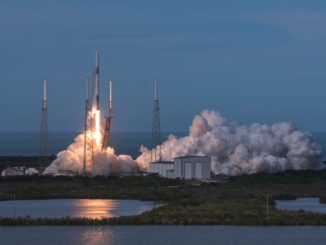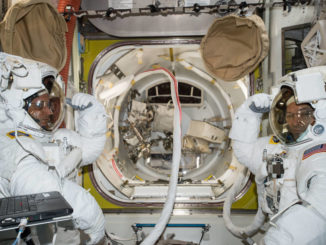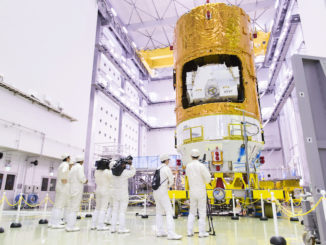CAPE CANAVERAL — Astronauts aboard the International Space Station used the robotic arm to snare a commercial cargo ship and bring it aboard this morning while traveling at five miles per second.
The Orbital ATK Cygnus freighter, dubbed the S.S. Rick Husband, was captured at 6:51 a.m. EDT (1051 GMT) by Expedition 47 commander and arm operator Tim Kopra floating in the station’s multi-window Cupola.
“Cygnus capture is complete,” Kopra radioed to Mission Control in Houston as the spacecraft flew 252 miles above the southern Indian Ocean.
“Houston copies. Excellent work gentlemen. Much appreciated. Made that look easy,” replied Jeremy Hansen, Canadian Space Agency astronaut serving as CAPCOM in Mission Control.
“And Houston we’d also like to say we are really honored to bring aboard the S.S. Rick Husband to the International Space Station, a personal hero to so many of us. And this will be the first Cygnus honoree who was directly involved with the construction of this great station,” Kopra added.
It capped a three-day journey for the ship from the launch pad to its destination, successfully rocketing into orbit Tuesday night atop a United Launch Alliance Atlas 5 booster from Cape Canaveral, Florida.
The freighter’s preliminary orbit was more than a hundred miles lower than the space station as it began the chase to systematically raise its altitude through a long series of maneuvers.

It was a textbook rendezvous this morning as Cygnus slowly approached the station from beneath the complex, stopping at a series of waypoints to verify all was normal. Expedition 47 flight engineer Tim Peake from the European Space Agency, also in the Cupola, made continual checks to ensure Cygnus was staying on course.
The craft eventually arrived 40 feet below, allowing the robot arm to capture a grapple fixture on Cygnus.
“It was a flawless rendezvous from start to finish for the Cygnus cargo craft, which was solid as a rock in its performance,” NASA commentator Rob Navias said.
“All of its rendezvous burns executed perfectly, all of the terminal phase of the rendezvous executed to perfection.”
The Canadian-made arm, under remote-operation via Mission Control, then maneuvered the vessel to the underside of Unity, the connecting module near the center of the station. Cygnus was delicately seated in the berthing mechanism, triggering the four “ready-to-latch” indicators at 10:37 a.m. EDT (1437 GMT).

Sixteen electrically-driven bolts in the Earth-facing port, commanded via laptop computer in the Destiny laboratory module by astronaut Jeff Williams, then engaged to firmly and officially install Cygnus at 10:52 a.m. EDT (1452 GMT), the 10th Commercial Resupply Services mission to reach the station and fourth by Orbital ATK.
“We are proud to be part of the machinery of human spaceflight and human presence in the exploration of space,” said Dan Tani, former space shuttle and station astronaut and now the senior director for mission and cargo operations at Orbital ATK.
“Orbital Sciences was one of the first successful private space companies to get stuff into orbit, back with the Pegasus launch vehicle. Orbital was really instrumental into bringing the private sector into space.”
NASA hired Orbital ATK and SpaceX to deliver cargo and goods to the International Space Station after the space shuttle fleet was retired. The next SpaceX launch is a few weeks away.
The Expedition 47 crew, now six-person strong with arrival of three fresh crew mates a week ago, intends to open the hatchway into Cygnus on Sunday morning to begin the arduous task of unloading thousands of pounds of supplies and putting it in the right locations.
“My friends in the astronaut office have sent some personal items for the crew. It is always great to find an Easter Egg, the little hidden surprises that the astronaut friends have put in there for them,” Tani said.

A welcome sign is placed just inside the hatch with a picture of Rick Husband, the namesake of the freighter. He was the pilot of the first space shuttle flight to dock with the International Space Station in 1999 and was the commander of Columbia’s ill-fated mission in 2003 in which the crew of seven was lost.
The S.S. Rick Husband is carrying:
-Crew supplies: 2,511 pounds
-Vehicle hardware: 2,443 pounds
-Science utilization: 1,713 pounds
-EVA gear: 346 pounds
-Computer resources: 216 pounds
The Cygnus is scheduled to spend 55 days at the station, through May 20, to be emptied of the “upmass” and then filled with about 4,000 pounds of trash and no-longer-needed items to be removed from the outpost.
“Just like your house, if you started collecting the garbage in your basement or your garage, you’d look forward to garbage day. So our departure is garage day on the space station,” Tani said.
“As big as the space station is, you’d be surprised how big of an issue storage space is. Anytime they can take this big ball of old food and T-shirts and towels and experiment cartridges and move it out of the way and have more room to store usable stuff, the better.”
After it leaves, the Cygnus will perform an internal experiment, called SAFFIRE, to observe the propagation of fire in microgravity, then deploy some cubesats before re-entering to a harmless disposal over the South Pacific.
“We expect to be in orbit about 8 days after unberth until re-entry. And that is to get all of the SAFFIRE data down to the ground,” Tani said.
What’s more, a Re-entry Breakup Recorder inside the module will characterize the destructive plunge into the atmosphere for playback via satellite to investigators after a survivable unit splashes down.
See earlier Cygnus OA-6 coverage.
Our Atlas archive.



